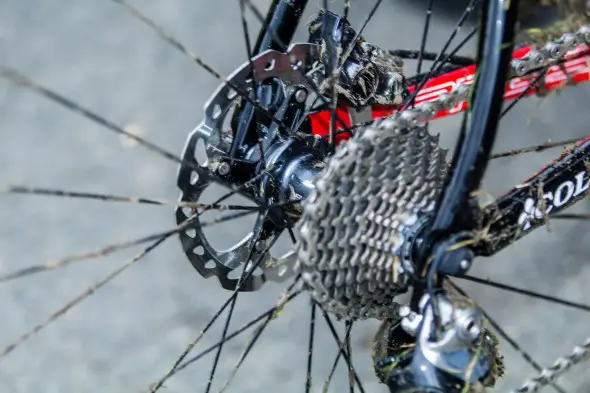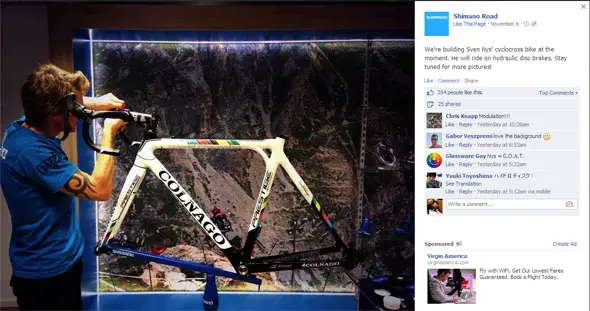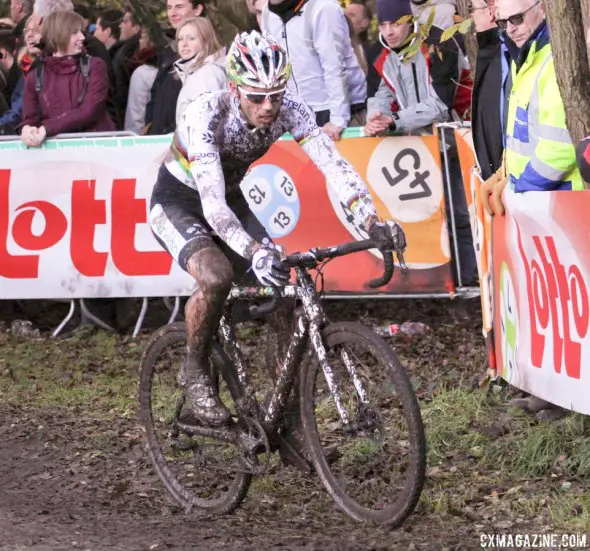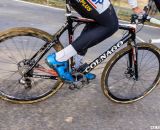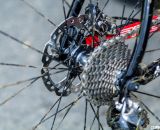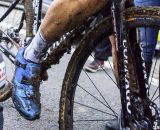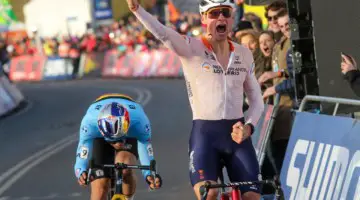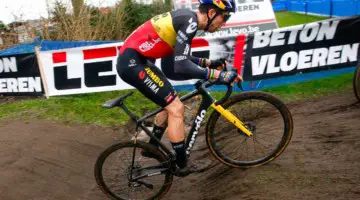Across the pond in Europe, cantilevers still dominate the pro field in top-level cyclocross races. But that’s starting to change.
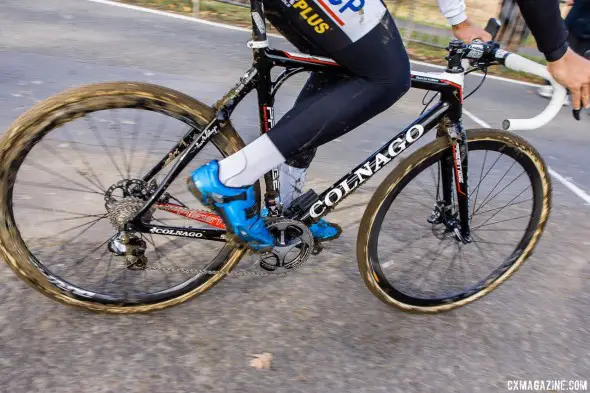
Niels Albert with Shimano R785 hydraulic disc brakes at the 2013 Koppenbergcross. © Cyclocross Magazine
While most American cyclocross professionals are racing disc brakes (and are also sponsored by American bike companies who sell disc brake cyclocross bikes), most Europeans have resisted switching to disc brakes (and for some teams, resisted 11-speeds).
American cyclocross powerhouses, including the whole Cannondale p/b CyclocrossWorld team, much of Rapha-Focus, and the men of Raleigh-Clement race on disc brakes. Cannondale’s Ryan Trebon is certainly happy with his braking power:
If you don't believe disc are future for CX. Let me tell you, you are most certainly mistaken
— Ryan Trebon (@ryantrebon) August 31, 2012
Even American company-sponsored European racers, like Helen Wyman (Kona) have won in Europe on disc brakes (see her Kona Super Jake cyclocross bike).
However, top-level European pros do not have bike companies as title sponsors but rather non-endemic mainstream businesses, since the sport is largely a spectator sport there. Selling bikes and components is not their sponsor’s primary goal, so in general, they can make equipment choices based on competitive advantage, or fear of change. Whatever the reason, disc brakes have not ruled the field in Europe, yet. Even Katie Compton left her disc brakes stateside when racing to her World Cup win in Tabor.
But just hours later in Tabor, Lars van der Haar, who committed to using disc brakes during the summer, piloted a hydraulic disc-equipped machine to his second World Cup win in a row after winning Valkenburg, using early versions of Shimano’s Ultegra-level R785 hydraulic disc brakes and 11-speed Di2 levers (see our initial Shimano R785 disc brake test and review). Van der Haar said they were an advantage in his racing.
The fact that Van der Haar’s win was the first World Cup win on disc brakes, and that they were early Shimano models, surprises us, as the SRAM Hydro Red and S700 hydraulic disc brakes have been widely available earlier, and SRAM-sponsored Compton has won on them in the States. It’s certainly good testing and validation for Shimano before the brakes and 11-speed levers are released later this year.
More recently, Niels Albert experimented with disc brakes on his Colnago Prestige cyclocross bike at the Koppenberg race, finishing eighth, but blaming hard training, not his brakes, on his disappointing finish. Still, at the Hamme-Zogge Superprestige a week later, Albert raced his TRP RevoX cantilever brakes exclusively, and won handily.
Sven Nys’ won this year’s CrossVegas with cantilever brakes, and told Cyclocross Magazine after the race that he had plans to switch to disc brakes, but not this season. (See 10 questions with Sven Nys). Well, it looks like the 2013 Cyclocross World Champion has changed his mind. Earlier last week, Shimano unveiled his new bike on their Facebook Page in preparation for Hamme-Zogge.
At Hamme-Zogge, Nys raced about half of his laps on a R785 disc brake-equipped Colnago Prestige cyclocross bike. Every lap, he went into the pits, switching from cantilevers to hydraulic disc brakes (see Nys swap between the different brakes in the Hamme-Zogge Superprestige race video here). He would start and finish on his Shimano CX70 cantilever brakes, and told media that the hydraulic brakes were the difference between “stopping” and “slowing down,” not necessarily what he wants while racing.
The biggest complaint Nys had was the weight. There’s no denying the weight penalty of disc brakes, with heavier calipers, hubs and levers and the added weight of rotors. Nys’ bike was also heavier because it’s basically his cantilever frame adapted for disc brakes, with added reinforcing for the disc brake mounts. That added weight can be avoided if the bike was built exclusively for disc brakes, as Specialized has told Cyclocross Magazine that their purpose-built carbon disc-brake equipped Crux frame is actually a bit lighter than their cantilever frame.
Nys’ team manager Jan Verstraeten said, “My personal feeling is that disc also provide an advantage in the mud.” But he also admitted to the weight penalty, saying the system weighs a half a kilogram extra.
“With the disc brakes is everything technically in order, but it’s still a matter of getting used to it. So that’s why at the end of the race i chose to use my regular bike.” Nys said after his race.
Will we see Nys’ fully commit to disc brakes? We think it’s unlikely for 2013, as Colnago doesn’t have multiple purpose-built disc brake bikes for Nys, but in 2014, when we see Nys switch to Trek, we’re guessing his primary bike will be a disc brake carbon version of the Crockett that Katie Compton is winning on.
Follow Cyclocross Magazine on Twitter and like us on Facebook to stay up-to-date on the latest cyclocross racing and tech news.
Niels Albert and Sven Nys Disc Brake Colnago Prestige Photo Gallery:













